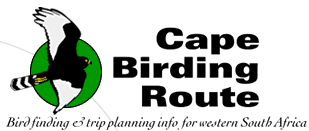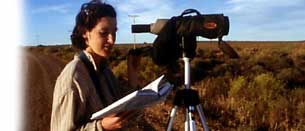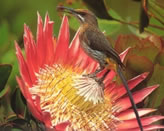Sir
Lowry's Pass:
This is a classic Cape birding spot in the Hottentots Holland
mountains, and provides easy access to two of the fynbos endemics
(Cape Rockjumper
and Victorin’s
Warbler) that, puzzlingly, do not occur on the Cape
Peninsula, despite an abundance of apparently ideal habitat.
Excellent fynbos birding may be had minutes from the viewsite
next to the N2 highway at the summit, just 50 minutes’
drive from the city (along the way, look out for Cape Town’s
steadily increasing House Crow population in the vicinity
of the N2 airport off-ramp). A rewarding birding walk at Sir
Lowry’s Pass can be completed in just two to three hours
– longer if you’re waylaid by the remarkable plant
diversity of these mountain slopes.
The
first hurdle lying between visiting birders and their quarry
is a blind corner, on the N2 highway: this needs to be crossed
on foot with considerable caution after parking at the viewsite
on the southern side of the road (at 1 on map, opposite).
Running north of the road is a rocky ridge of minor outcrops
leading up to the summit of Kanonkop peak at 2. Winding along
its eastern contour is a broad track (3) leading north towards
a neck in the mountains at 4 called Gantouw Pass (after the
Khoikhoi word for Eland, as this was once the route taken
by migrating antelope). Here you will see deep ruts in the
soft sandstone, a legacy of the east-bound ox-wagons of traders
and those who became restive under British rule in the Cape
two centuries ago. By 1821, 4 500 wagons a year were making
the crossing, a journey of such epic proportions that one
in five wagons never survived it! Close by lie a pair of antique
signal cannons that were later installed at the pass. The
rocky slopes here are the domain of the Cape
Rockjumper (p.73*). The entire length of the ridge
between the N2 viewsite and the summit of Kanonkop is in fact
prime Cape
Rockjumper country, and birders alert to its loud,
piping call can be sure to locate a group of these fine birds
here (see box opposite).
Birds
are scarce in this landscape, but the area does have its rewards.
The series of rocky outcrops along the path and the ridges
above also hold low densities of Ground
Wood-pecker (p.105*), Familiar Chat, Cape
Siskin (p.33*), Cape Rock Thrush and, rarely,
Sentinel Rock Thrush. Common birds of the dense fynbos
between the ridge and gravel track are Grassbird, Orange-breasted
Sunbird (p.33*), Neddicky, and Karoo Prinia.
Cape
Sugarbird (p.33*) and Yellow-rumped Widow occur
more sparsely in denser vegetation, such as that growing along
the stream under the powerlines.
Victorin’s
Warblers (p.73*) can be
heard singing from the slightly denser vegetation of the hill
slopes. Those unfamiliar with its call should take care to
distinguish it from the superficially similar, but less repetitive,
song of the more conspicuous Grassbird. Victorin’s
Warblers are far more readily lured from cover in
this relatively open habitat than in their more typical haunts
in impenetrable streamside thicket, such as that found beneath
the powerlines at Gantouw Pass, where they are common. Another
good area to look for them is in the dense vegetation along
the railway track at the bottom of the mountain at 6. To reach
this spot, drive past the viewsite, turn left opposite the
entrance to Steenbras Dam, and park at the gate. This area
also supports Striped Flufftail, although this species
is almost impossible to see during the day.
Jackal
Buzzard (including at least
one potentially confusing white-breasted individual; see p.99),
Rock Kestrel and Peregrine Falcon are the most
frequently seen raptor species at Sir Lowry’s Pass, although
numerous others occasionally pass through the area. These
include Black and Martial Eagles, Black
Harrier (p.57*) and Red-breasted Sparrowhawk.
Over
the crest of Sir Lowry’s Pass, the N2 continues eastwards
across a rolling plateau, largely covered in timber plantations
and South Africa’s most important deciduous fruit orchards,
before dropping suddenly into the wheat-swathed lowlands of
the Overberg (see p.63).
|


